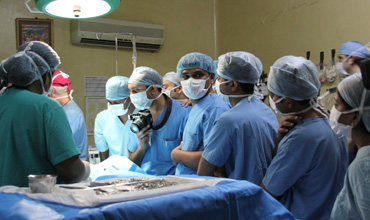Medicine: Prevalence and Types of Injuries among Patients treated in Teaching Hospital, Batticaloa

Abstract:
Background: Injuries are the leading causes of death,
hospitalizations and disabilities.
Traumatic injuries, poisoning and burns are the major types of injuries
reported in Sri Lanka, according to the National Health Statistics. Life style
changes such as using alcohol and increasing of vehicle usages are believed to
be having relation with the prevalence of injuries. Gender and age group also
have effects on types of injuries.
Objective:
To identify the prevalence of
various types of acute injuries in Batticaloa, Teaching Hospital.
Method: It is a cross sectional descriptive study involving
simple random sample of one hundred and ninety one (206) injured patients who were atmitted at Teaching Hospital, Batticaloa.Data was collected by using a pre designed
structured interviewer administered questionnaire.
Results: Altogether, 206 patients with an age range of 01-80
years were studied. Males accounted for 62.8 % of the study sample. Majority of
causes are dog bite (33.5 %), and RTA (24.2 %), fall injury (16 %), poisoning
(6.3 %) and Cat bite (8.7 %).Among that, 50 % injuries are occur due to the
animals in whole injuries. There was a significant relationship between age
groups and causes of injuries and there was no relationship between habit of
alcohol use and accidental injuries. Among body parts, upper limb (35 %) and
lower limb (53 %) are most often affected by injuries. 11. 165 % of injured
people get disabilities due to their injuries.
Conclusion:
According to this study, majority
of injuries are caused by dog bites, road traffic accidents (RTA), fall
injuries, poisoning and cat bites respectively. Considering the affected body
parts, injuries in upper extremities and lower extremities are more common.
Around 11. 2 % of patients get disabilities as the consequences of their
injuries.
References:
[1]. World
Health Organization (WHO), NLM classification: WA 530.1, The world health
report, 2006.
[2]. Lamawansa MD, Piyathilake
A. Incidence of Physical Injuries in a Rural Community in Sri Lanka: Results
of the First Community Survey in Sri Lanka. Indian
J Community Med2008; 33(4): 238–242.
[3]. Ministry of
Health, Sri Lanka, National Policy & Strategic Framework on Injury
Prevention & Management in Sri Lanka, 2009.
[4]. Ministry of Health, Sri Lanka, Annual Health Bulletin, 2009.
[5]. Navaratne
KV, Fonseka P, Rajapakshe L,
Somatunga L, Ameratunga S, Ivers R,
Dandona R. Population-based
estimates of injuries in Sri Lanka, Inj Prev2009; 15:170-175.
[6]. World
Health Organization (WHO), World Health Survey, 2002.
[7]. Bhalla K, Navaratne KV, Shahraz S, Bartels D, Abraham J, Dharmaratne
S. Estimating the incidence of road traffic fatalities and injuries in Sri
Lanka using multiple data sources, International Journal of Injury Control and
Safety Promotion2010; 17(4): 239-246.
[8].
Alamode SB, Dharmaratne SD, Alamode TC. Incidence and predictors of onboard
injuries among Sri Lankan flight attendants, BMC
Public Health2009; 9:227.
[9]. Kobusingye
O, Guwatudde D, Lett R. Injury patterns in rural and urban Uganda, Inj Prev
2001; 7:46-50.
[10].
Ekstrand J, Hägglund M, Waldén M. Injury incidence and injury patterns in professional football, Br J Sports Med 2011;45:553-558.
[11]. McManus A, Cross DS. Incidence of
injury in elite junior Rugby Union, Journal of Science and Medicine in Sport
2004; 7(4):438-445.
[12].
Saadat
S, Mafi M, Alhoseini
MS.
Population based estimates of
non-fatal injuries in the capital of Iran,
BMC Public Health 2011; 11:608.
[13]. Nilambar J, Srinivasa DK, Gautam
R, Jagdish Epidemiological study of road traffic accident cases, Indian Journal
of Community Medicine2004; 29(1):20-20.
[14]. Agarvval N, Reddaiah VP. Knowledge,
attitude and practice following dog bite, Health and Population Perspective and
Issues 2003; 26 (4):154-161.
[15]. Etman
A, Wijlhuizen GJ, Heuvelen MJ, Chorus A, Hopman M. Falls incidence
underestimates the risk of fall-related injuries in older age groups, Age and
Ageing 2012; 41: 190–195.
[16]. Weerawardena WAK, Illanagasingha
TDB1, Piyadasa IJ, Rathnayaka SM, Subaweera WTDUPL, Niroshana GAL. Analysis of
patients admitted with history of road traffic accidents to surgical unit B
Teaching Hospital Anuradhapura, Sri Lanka, Anuradhapura
Medical Journal 2013; 7(1): 2-5.

